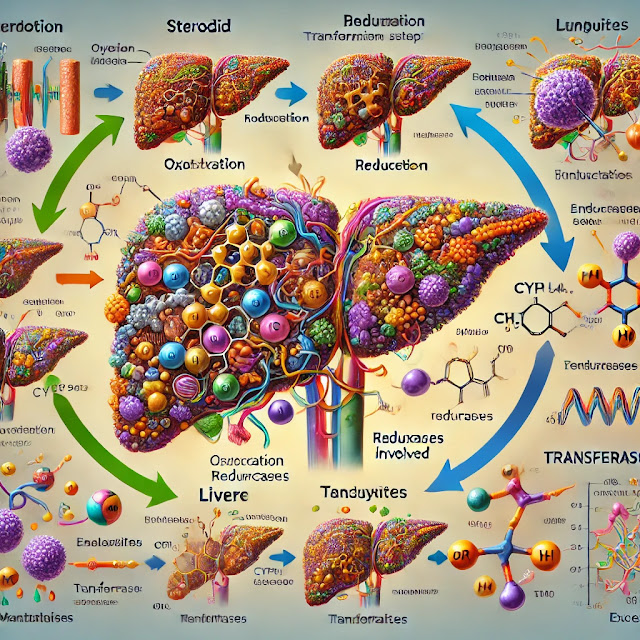Biotransformation of steroids refers to the metabolic process by which steroid molecules are chemically modified within the body. This typically occurs in the liver and involves enzymatic reactions that make the steroids more water-soluble for excretion via urine or bile. The primary aim of steroid biotransformation is to detoxify these compounds and facilitate their elimination.
Phases of Steroid Biotransformation:
Phase I (Functionalization Reactions):
- Involves the introduction of or modification to functional groups (e.g., hydroxylation, oxidation, reduction).
- Enzymes involved: Cytochrome P450 (CYP) enzymes play a major role here.
- Hydroxylation: Hydroxyl groups (-OH) are added to the steroid structure, increasing its polarity. For example, testosterone can be hydroxylated to form more polar metabolites.
- Oxidation: Ketone groups can be introduced through oxidation, such as converting 17β-hydroxy steroids into 17-ketosteroids.
Phase II (Conjugation Reactions):
- This phase involves conjugating the steroid or its metabolites with more polar molecules, making them highly soluble in water.
- Common conjugation reactions:
- Glucuronidation: Addition of glucuronic acid to hydroxyl groups via the enzyme UDP-glucuronosyltransferase (UGT). This process increases water solubility and promotes excretion in urine.
- Sulfation: Involves conjugation with sulfate groups via sulfotransferases, enhancing excretion in both urine and bile.
- Methylation: A methyl group (-CH₃) may be added to certain functional groups, impacting the steroid's activity and solubility.
Specific Steroids and their Biotransformation:
- Corticosteroids (e.g., cortisol): Undergo reduction of the double bonds in the steroid structure and subsequent conjugation reactions, like glucuronidation and sulfation.
- Androgens (e.g., testosterone): Metabolized primarily by hydroxylation and subsequent glucuronidation to inactive metabolites.
- Estrogens (e.g., estradiol): Hydroxylated to form catechol estrogens, followed by conjugation reactions like methylation, glucuronidation, and sulfation.
Clinical Significance:
- Drug Interactions: Certain drugs can inhibit or induce CYP enzymes, altering the metabolism of steroid drugs or endogenous hormones, and leading to altered efficacy or toxicity.
- Steroid Hormone Therapy: Understanding biotransformation is crucial in hormone replacement therapy and cancer treatments involving steroids, as the metabolic rate influences drug duration and effects.
In essence, the biotransformation of steroids ensures their detoxification, solubility, and excretion, contributing to the regulation of steroid hormone levels and the management of synthetic steroid drugs in the body.













0 Comments
Thanks for your feedback, ll get back to you soon